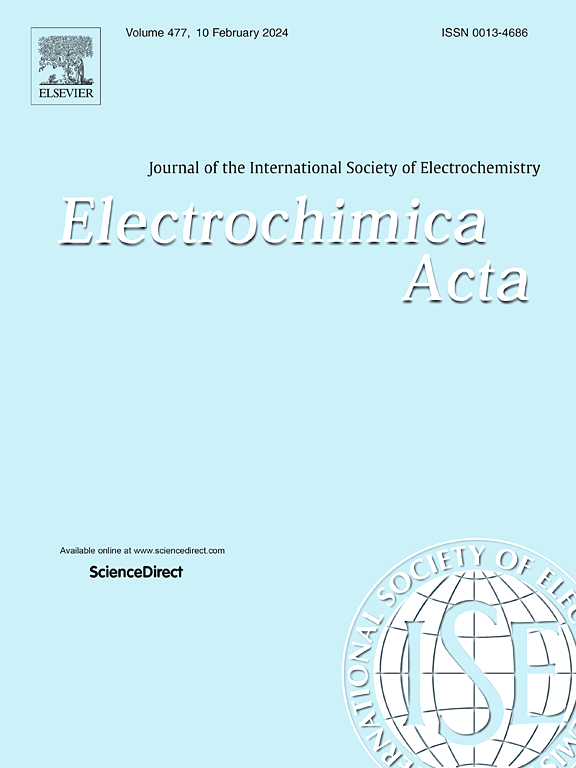Mesoporous carbon materials doped with Co, Fe and nitrogen as oxygen reduction reaction electrocatalysts for anion-exchange membrane fuel cell
IF 5.5
3区 材料科学
Q1 ELECTROCHEMISTRY
引用次数: 0
Abstract
Mesoporous carbons (MCs) are prepared using dual-templating and doped with cobalt, iron and nitrogen for electrocatalytic applications and are characterised using various physico-chemical methods. Prepared materials are employed as oxygen reduction reaction (ORR) electrocatalysts and cathode catalysts of an anion-exchange membrane fuel cell (AEMFC). The MC materials are prepared using two novel and sustainable phenolic resin synthesis routes, while employing an easily removable soft template and MgO as a hard template to obtain feasible mesoporous texture. The content of MgO is varied in dual-templating to assess its influence on the porous structure and electrocatalytic properties. Doping is done via high-temperature pyrolysis using cobalt and iron acetate as transition metal sources and 1,10-phenanthroline as a nitrogen source. The physico-chemical characterisation shows that the preparation of MC materials and their subsequent doping has been successful. The initial assessment employing the rotating disc electrode method indicates that the synthesised catalyst materials exhibit very high electrocatalytic activity towards the ORR in alkaline media and good stability by applying 10,000 potential cycles. In AEMFC testing, the most promising cathode catalyst reveals excellent fuel cell performance by obtaining a peak power density above 500 mW cm–2, almost the same performance as with commercial mesoporous Fe-N-C catalyst. Thus, the novel dual-templating approach taken herein enables to prepare sustainable non-precious metal electrocatalysts with feasible porous characteristics for the AEMFC application.
掺杂Co、Fe和氮的介孔碳材料作为阴离子交换膜燃料电池氧还原反应的电催化剂
采用双模板法制备了用于电催化应用的介孔碳 (MC),并在其中掺杂了钴、铁和氮。制备的材料被用作氧还原反应(ORR)电催化剂和阴离子交换膜燃料电池(AEMFC)的阴极催化剂。MC 材料的制备采用了两种新颖且可持续的酚醛树脂合成路线,同时采用了易于去除的软模板和氧化镁作为硬模板,以获得可行的介孔质地。在双模板中,氧化镁的含量有所不同,以评估其对多孔结构和电催化性能的影响。采用钴和醋酸铁作为过渡金属源,1,10-菲罗啉作为氮源,通过高温热解进行掺杂。物理化学特性分析表明,MC 材料的制备和随后的掺杂都很成功。采用旋转圆盘电极法进行的初步评估表明,合成的催化剂材料在碱性介质中对 ORR 具有极高的电催化活性,并且在 10,000 次电位循环中具有良好的稳定性。在 AEMFC 测试中,最有前途的阴极催化剂显示出卓越的燃料电池性能,峰值功率密度超过 500 mW cm-2,与商用介孔 Fe-N-C 催化剂的性能几乎相同。因此,本文所采用的新颖双模板方法能够制备出具有可行多孔特性的可持续无贵金属电催化剂,用于 AEMFC 应用。
本文章由计算机程序翻译,如有差异,请以英文原文为准。
求助全文
约1分钟内获得全文
求助全文
来源期刊

Electrochimica Acta
工程技术-电化学
CiteScore
11.30
自引率
6.10%
发文量
1634
审稿时长
41 days
期刊介绍:
Electrochimica Acta is an international journal. It is intended for the publication of both original work and reviews in the field of electrochemistry. Electrochemistry should be interpreted to mean any of the research fields covered by the Divisions of the International Society of Electrochemistry listed below, as well as emerging scientific domains covered by ISE New Topics Committee.
 求助内容:
求助内容: 应助结果提醒方式:
应助结果提醒方式:


